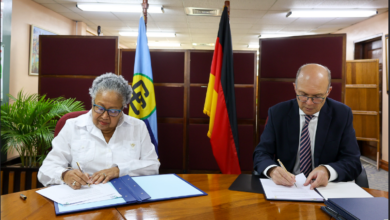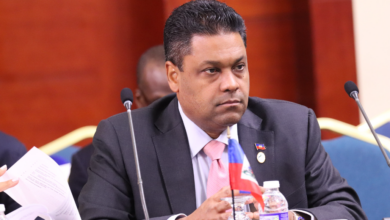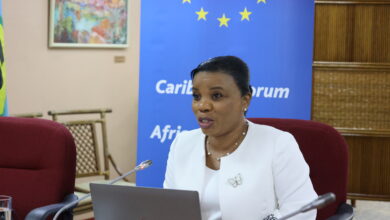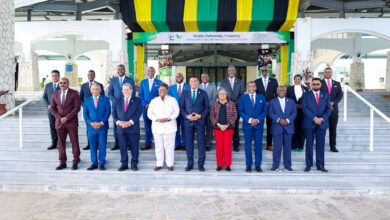When CARIFESTA VIII – the Caribbean’s premier cultural event – winds down on August 30th in Suriname, organisers hope they would have found the answer to one of the most important questions: “where do we go from here.”
“This is not going to be just another gathering. We’re going to look at whether we need to reinvent CARIFESTA. This is the eighth time we are coming together like this and we always followed a certain pattern. Do we need to continue like this? Or do we need to create a different model?” says Dr. Carol Bishop, CARIFESTA Coordinator for the Caribbean Community (CARICOM). Her wish is that CARIFESTA would present the solutions to many questions with which Caribbean cultural ambassadors struggle.
“It is a matter of ignorance sometimes,” she said. “We ourselves in the Caribbean do not know what we can produce and how well we can produce it. It’s very sad that we allow people from outside the region to recognise it and exploit it. It is critical that we ourselves recognise the excellence of our work. We have got to ensure that the people that do this work – our artists – are not neglected. The work they do has value. Not only for them, it also has economic value for our entire region. If we recognise this we can lift the region to higher heights,” she added.
CARIFESTA VIII kicks off on August 24th under the theme “Cultural Diversity.” The festival that’s been hailed with presenting the Caribbean at a glance is this year being held in Suriname, a country with a rich cultural diversity and cohesion.
Henk Tjon, the Artistic Director for the festival said the former Dutch colony and CARICOM’s first non-English speaking member would take advantage of the opportunity to showcase its own culture. He added that Suriname too will also create the stage on which its Caribbean sister nations can jointly exhibit their art and culture and look towards the future of that element that can play a vital role in their development.
Visitors and participants alike will be embraced as family. “Welcome home! That’s how they will be greeted from when they touch down at the airport. Everywhere they’ll go –be it in Paramaribo or in the distant districts- they will be able to enjoy our music and that of our Caribbean family. Seketi, kaseko, awasa, calypso, turbangan, tambura, maraca; they’ll hear everything. There will be events all over the country. In the districts these events will be coordinated by the local performers and the participating visitors will be able to join in. In the Grand Market we’ll present our art and everything on display will have to be of quality. That’s what we demand: excellence. Our best. It will be a small version of the United Nations,” said Tjon.
Indeed, as the printed programme for CARIFESTA Vlll outlines, “every angle has been covered.” It reads: “From drama to musical, from folklore to traditional dance, music in every style and theatre in every form.”
There are also promises of surprises, such as the possibility that performing artists join forces and create new theatre productions on the spot. Indeed, “that will enable audiences to witness what CARIFESTA is all about: the inspirational exchange of creative flows.”
Five Caribbean artists – Richenel Lieveld, Soeki Irodikromo and Cornelly Aloema of Suriname, Phillip Moore of Guyana and Leroy Clarke of Trinidad and Tobago- will be honored during a special exhibition in the majestic Presidential Palace on the Independence Square in Paramaribo.
In addition to the exhibition in the Palace and the Grand Market, the CARIFESTA VIII programme promises a wide range of artistic and cultural events. A country that prides itself on being a prime example of ethnic diversity, Suriname has encouraged all its residents to express their ethnic background all through the festival. Tjon, himself involved in CARIFESTA from when it was first staged in Guyana in 1972, is excited about bringing the event “home.” “It will be fantastic. People will be wearing their sarong, their koto, their panyi, their sawawa … something of their culture to work,” he said.
The CARICOM CARIFESTA Coordinator Carol Bishop also knows what to expect. “People can expect an experience that will lay emphasis on a process that will highlight the Caribbean as a region of rich diversity. And the festival is also an ideal place for the coming together of the Caribbean family to share its creativity and its artistic expressions as a culturally rich and ethnically diverse family,” she said. “Especially the Grand Market will show the excellence of Caribbean region. We’re encouraging people to come and show their talent.”
Dr. Bishop said the name CARIFESTA indicates that this festival is about the Caribbean. “We’re emphasising the “cari” of this. I’m hoping that out of this comes regional recognition of the importance of culture,” she added. This is expected to be placed on the front burner.
She explained that during the symposia, three of which are planned, emphasis would be placed on getting to a regional direction for Caribbean art and culture. The importance of preserving the elements that are of crucial value to the Caribbean has to be stressed
“I expect that the participants will voice concerns and call for resolutions of what they would like to see happen with art and culture,” she said.
The CARICOM CARIFESTA Coordinator recalled that during a recent meeting of the Regional Cultural Committee, members looked at the development of national cultural policies. A regional policy was endorsed by the Culture Ministers of the CARICOM Member States. The Committee also stressed that each country should have its own national policy, in which its peculiarities were considered.
Turning attention to another important aspect of culture, Dr. Bishop said there is a nexus between culture and economic development and that for too long this has been ignored. Creating more understanding for that fact will also be examined during the symposia.
“For too many years people saw culture as people going to dance, sing and play music. We’re going to look at intellectual property. Are we being exploited? What do we have in place to ensure that artists receive their due rewards? … Culture and trade were mostly kept apart, but people are starting to see the importance of culture in trade. The contribution that culture can have for economic development is now beginning to be realised,” she said.
During a meeting of CARICOM’s Council Human and Social Development (COHSOD), serious note was taken of this. Agreements were reached that all efforts would be made on the national and regional levels to ensure that the tool of culture would be used more in the economic development of Caribbean nations.
Said Bishop: “We see culture as a way of life. It’s very comprehensive. Not just music; not just dance. Our goal is to promote culture in any aspect of CARICOM. People have got to understand and appreciate their culture and that of others.”
No less than 24 countries have committed to participate in the prestigious festival. Hundreds of dancers, artists, musicians, actors, representing these countries are set to make the event live up to its fame of the Greatest Cultural Mix of All Times.
Organisers are determined to make the event much more than just another display of Caribbean art and culture. “It will be a reunion of Caribbean excellence,” said Henk Tjon. He expects that the event will be an unforgettable experience for the Caribbean people and for Suriname in particular.





